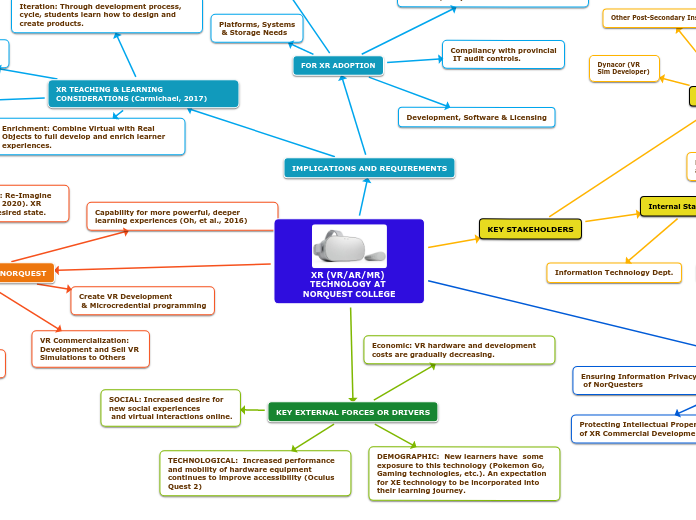によって Derek McCurdy 5年前.
408
Backup_XR (VR/AR/MR) TECHNOLOGY AT NORQUEST COLLEGE
開く
XR (VR/AR/MR) TECHNOLOGY AT
NORQUEST COLLEGE BARRIERS & RISKS Mitigation Approaches Proactively conduct pre-audit activities to ensure privacy and security considerations are met Work with legal services to ensure IP protections of commercial XR assets Reduce simulation costs by development pooling resources with other post-secondaries. Apply for grant funding. Work with Advancement to establish
technology support fund for learners Work with IT, Security & Privacy Teams Compliancy with Provincial
IT Audit Requirements Protecting Intellectual Property
of XR Commercial Developments Ensuring Information Privacy
of NorQuesters Security: Protection of XR Data and Assets Ensuring Equity of Access for Learners & Employees to VR Equipment Rapidly changing XR technologies lead to obsolence High Cost of current XR Development (e.g.: $100k/simulation from past NorQuest VR simulations) POTENTIAL BENEFITS TO NORQUEST XR can provide more connection & collaboration experiences for remove or work-from-home workers (Resnick, 2016) Capability for more powerful, deeper learning experiences (Oh, et al., 2016) Enhance College retail experiences (Bookstore) (Jobillico, 2020) Immersive simulation training &
employee onboarding experiences Enhanced testing and Assessment opportunities VR Commercialization:
Development and Sell VR
Simulations to Others Create VR Development
& Microcredential programming Alignment to College Mission: Re-Imagine Higher Education (NorQuest, 2020). XR adoption was identified as desired state. Vocational, digital media & communications opportunities Open House & Virtual Tours KEY STAKEHOLDERS External Partners Workforce & Industry
(Oil & Gas, Retail, Tourism) Healthcare Providers
(Covenant Care,
Alberta Health Services) Other Post-Secondary Institutions Dynacor (VR Sim Developer) Government of Alberta ELIXR (Enhanced Learning in Extended Reality) Consortium Internal Stakeholders NorQuest Leadership
and Executive Academic Research
& Curriculum Development Workforce Integrated Learning Information Technology Dept. Faculty and instructors IMPLICATIONS AND REQUIREMENTS FOR XR ADOPTION Platforms, Systems
& Storage Needs Development, Software & Licensing Privacy Impact Assessments (PIA) and Security Assessments (SA's) required. Compliancy with provincial
IT audit controls. Infrastructure and Device investments (network, VR headsets, PCs, VR application software, etc.) XR TEACHING & LEARNING CONSIDERATIONS (Carmichael, 2017) Iteration: Through development process, cycle, students learn how to design and create products. Gamification: Use of XR can 'gamify' curriculum to improve engagement Flip the Experience: Make it Learner-Centered Enrichment: Combine Virtual with Real Objects to full develop and enrich learner experiences. KEY EXTERNAL FORCES OR DRIVERS DEMOGRAPHIC: New learners have some exposure to this technology (Pokemon Go, Gaming technologies, etc.). An expectation for XE technology to be incorporated into their learning journey. TECHNOLOGICAL: Increased performance and mobility of hardware equipment continues to improve accessibility (Oculus Quest 2) Economic: VR hardware and development costs are gradually decreasing. SOCIAL: Increased desire for
new social experiences
and virtual interactions online.

